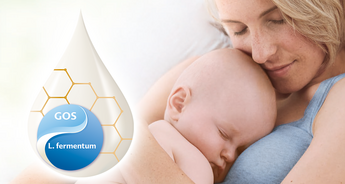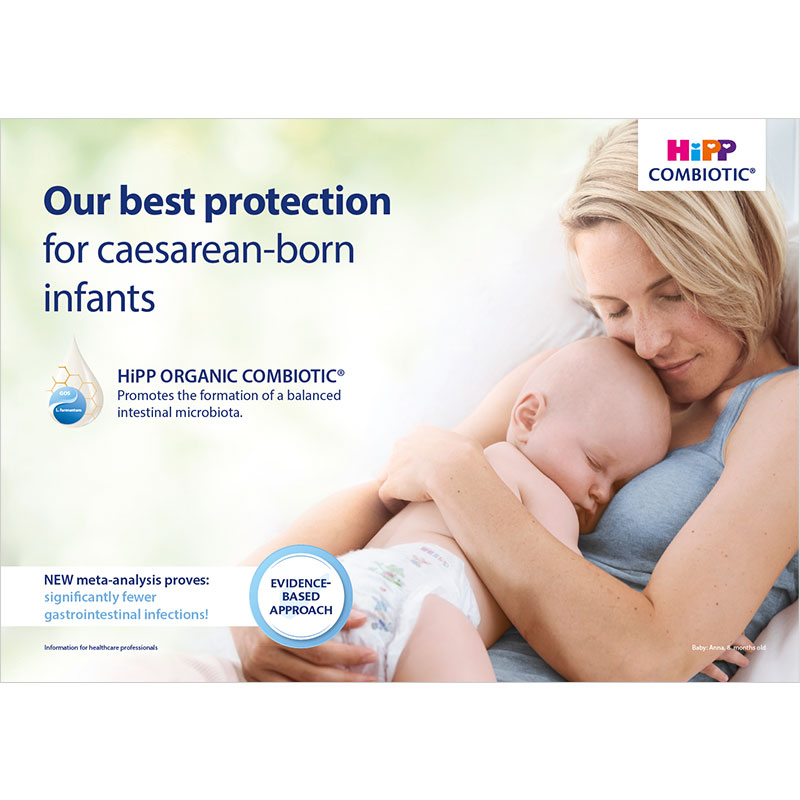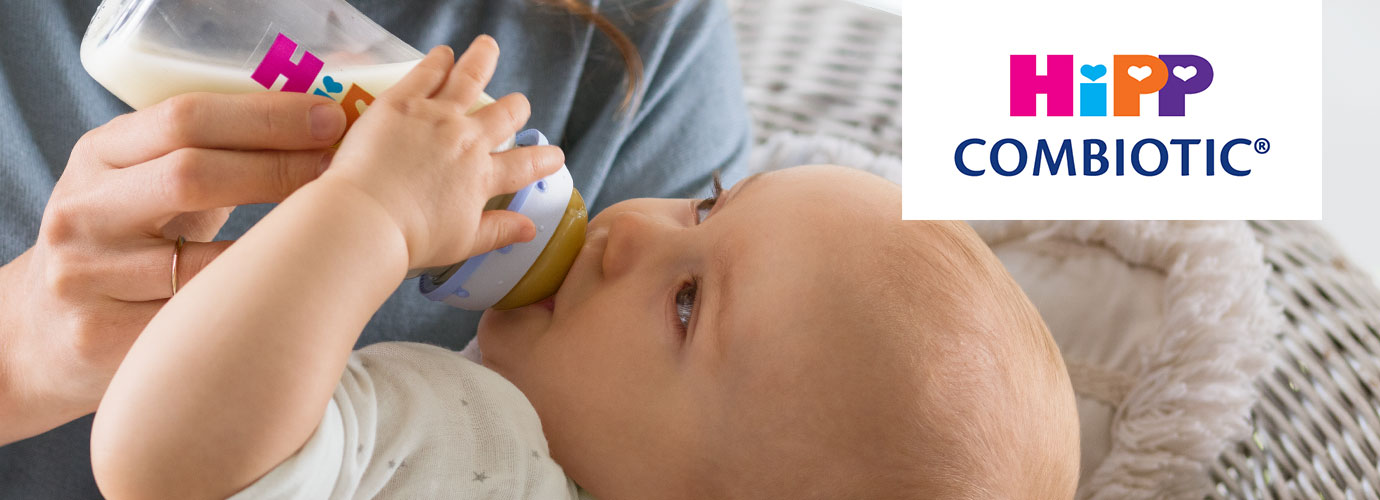HiPP ORGANIC COMBIOTIC® promotes the formation of a balanced intestinal microbiota.
NEW: Our best protection for caesarean-born infants
Caesarean-born infants who are not breastfed need special protection. The intestinal microbiota in caesarean-born infants is different to that of vaginally born infants1, 2, making the former more prone to infections, allergies or other diseases3. Human milk contains both pre- and probiotics, making it an ideal catalyst for favourable colonisation of the infant’s intestine4. HiPP ORGANIC COMBIOTIC® particularly benefits caesarean-born infants who are not breastfed.
HiPP ORGANIC COMBIOTIC® promotes the formation of a balanced intestinal microbiota

Feeding a formula containing a combination of pre- and probiotics has been proven to promote the formation of a healthy intestinal microbiota, thereby supporting the infant’s immune development. A recent meta-analysis showed the beneficial effect of a formula fortified with the probiotic L. fermentum CECT5716 in caesarean-born infants who are not breastfed5.
HiPP ORGANIC COMBIOTIC® contains the combination of L. fermentum CECT5716, a probiotic bacterial strain isolated from human milk, and the prebiotic galacto-oligosaccharides (GOS).

New video! The intestinal microbiota in caesarean-born infants
Watch our latest VIDEO to find out more about the influence of beneficial intestinal microbiota specifically for caesarean-born infants.
Caesarean-born infants start out with fewer lactobacilli in their system
Lactobacilli lay the foundation for a balanced intestinal microbiota
- The intestinal microbiota of newborns is composed of microbes of maternal intestinal and vaginal flora, which are transferred during a vaginal birth.
- With a caesarean delivery, there is no bacterial transfer of these beneficial maternal microbes.
- Lactobacilli, which play an important role in forming the intestinal microbiota, are underrepresented in caesarean-born infants10.
Graph: Intestinal colonisation during the first weeks of life

Graph: Intestinal colonisation: Comparison of vaginal delivery and caesarean delivery
Breastfeeding seems to be another key factor in the formation of the intestinal microbiota in infants11. Human milk contains both pre- and probiotics, making it an important catalyst for favourable colonisation of the infant’s intestine and can partially counter the negative effects of a caesarean delivery on a child’s intestinal microbiota4. However, women who deliver their children by caesarean section are less likely to breastfeed and if they do breastfeed, they are more likely to start later and stop earlier12,13. The primary goal should be to increase the breastfeeding rate, especially following caesarean sections.
The proven combination of the natural lactic acid culture L. fermentum CECT5716 and prebiotic GOS in HiPP ORGANIC COMBIOTIC® promotes the development of healthy intestinal microbiota and thereby protects infants from the inside. Proven by a recent meta-analysis of three double-blind, randomised clinical trials5.
Suitable HiPP info material

References:
1 Jakobsson, H.E. et al.: Decreased gut microbiota diversity, delayed bacteroidetes colonisation and reduced Th1 responses in infants delivered by caesarean section. Gut 63 (2014) 559–566.
2 Kim, G. et al.: Delayed establishment of gut microbiota in infants delivered by cesarean section. Front Microbiol. 11 (2020) 2099. doi: 10.3389/fmicb.2020.02099.
3 Słabuszewska-Jozwiak, A. et al.: Pediatrics consequences of caesarean section – A systematic review and meta-analysis. Int. J. Environ. Res. Public Health 17 (2020) 8031.
4 McGuire, M.K.; McGuire, M.A.: Human milk: Mother nature’s prototypical probiotic food? Adv. Nutr. 6 (2015) 112–123.
5 Blanco-Rojo, R. et al.: Beneficial effects of Limosilactobacillus fermentum CECT5716 administration to infants delivered by cesarean section. Front. Pediatr. (2022) doi.org/10.3389/fped.2022.906924.
6 Blaut M & Loh C in: Bischoff SC: Probiotika, Präbiotika und Synbiotika; Thieme 2009; 2–23.
7 Liu, Y. et al.: The perturbation of infant gut microbiota caused by cesarean delivery is partially restored by exclusive breastfeeding. Front. Microbiol. 10 (2019) 598. doi: 10.3389/fmicb.2019.00598.
8 Maldonado, J. et al.: Human milk probiotic Lactobacillus fermentum CECT5716 reduces the incidence of gastrointestinal and upper respiratory tract infections in infants. J Pediatr Gastroenterol Nutr 54 (2012) 55–61.
9 Gil-Campos, M. et al.: Lactobacillus fermentum CECT 5716 is safe and well tolerated in infants of 1-6 months of age: a randomized controlled trial. Pharmacol Res 65, 2 (2012) 231–238.
10 Yang, B. et al.: Bifidobacterium and Lactobacillus composition at species level and gut microbiota diversity in infants before 6 weeks. Int. J. Mol. Sci. 20 (2019) 3306; doi:10.3390/ijms20133306.
11 Martin-Pelaez, S. et al.: The Impact of Probiotics, Prebiotics, and Synbiotics during pregnancy or lactation on the intestinal microbiota of children born by cesarean section: A systematic review. Nutrients 14 (2022) 341.
12 Regan, J.T.A.; DeFranco, E.: The influence of mode of delivery on breastfeeding initiation in women with a prior cesarean delivery: A population-based study. Breastfeed. Med. 8 (2013) 8, 181–186.
13 Hobbs, A.J. et al.: The impact of caesarean section on breastfeeding initiation, duration and difficulties in the first four months postpartum. BMC Pregnancy and Childbirth 16, 90(2016). DOI 10.1186/s12884-016-0876-1.
* Breast milk contains a variety of natural cultures which can vary individually.


